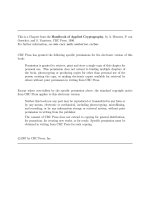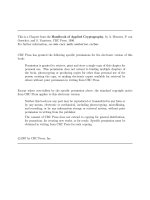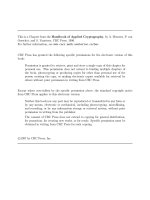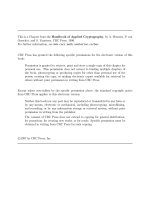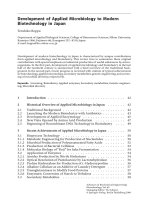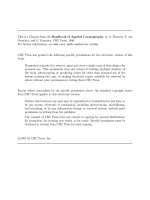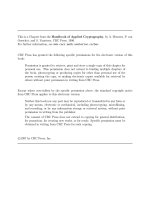principles of applied reservoir simulation
Bạn đang xem bản rút gọn của tài liệu. Xem và tải ngay bản đầy đủ của tài liệu tại đây (26.68 MB, 376 trang )
Principles
of
Applied
Reservoir Simulation
This page intentionally left blank
Second
Edition
_£
Gulf
Professional Publishing
ii
an
imprint
of
Butterworth-Heinemann
Amsterdam Boston
Heidelberg
London
New
York Oxford Paris
San
Diego
San
Francisco Singapore Sydney Tokyo
Principles
of
Applied
Reservoir
Simulation
Gulf
Professional
Publishing
is an
imprint
of
Elsevier.
Copyright
€>
2001
by
Elsevier (USA).
All
rights reserved.
Originally
published
by
Gulf
Publishing
Company, Houston,
TX.
No
part
of
this
publication
may be
reproduced, stored
in
a
retrieval system,
or
transmitted
in any
form
or by any
means, electronic, mechanical,
photocopying,
recording,
or
otherwise,
without
the
prior
written
permission
of
the
publisher.
Permissions
may be
sought directly
from
Elsevier's Science
&
Technology
Rights
Department
in
Oxford,
UK:
phone: (+44)
1865
843830, fax: (+44)
1865
853333,
e-mail:
You may
also
complete
your
request
on-line
via the
Elsevier Science homepage
(),
by
selecting
'Customer
Support'
and
then
'Obtaining
Permissions'.
/~"^%
^*
This book
is
printed
on
acid-free
paper.
Library
of
Congress
Cataloging-in-Publication
Date
Fanchi,
John
R.
Principles
of
applied
reservoir
simulation/John Fanchi.
- 2
nd
edition
p. cm.
Includes bibliographical references
and
index.
ISBN
0-88415-372-X(alk.
paper)
1.
Oil fields-Computer
simulation.
2.
Petroleum-Geology-Mathematical models.
I.
Title
TN870.53.F36
2000
622'.3382'0113-dc21
00-064650
British
Library
Cataloguing-in-Pulication
Data
A
catalogue record
for
this book
is
available
from
the
British
Library.
The
publisher
offers
special discounts
on
bulk orders
of
this book.
For
information,
please
contact:
Manager
of
Special Sales
Elsevier Science
200
Wheeler Road
Burlington,
MA
01803
Tel:
781-313-4700
Fax:
781-313-4802
For
information
on all
Gulf publications available, contact
our
World Wide
Web
homepage
at
/>10
9 8 7 6 5 4 3 2
Printed
in the
United
States
of
America.
Disclaimer:
Some images in the original version of this book are not
available for inclusion in the eBook.
To my
parents,
John
A. and
Shirley
M.
Fanchi
This page intentionally left blank
About
the
Author
xiv
Preface
to
Second
Edition
xv
Preface
to
First Edition
xvi
1
Introduction
to
Reservoir Management
1
.,1
Consensus Modeling
2
1.2
Management
of
Simulation Studies
4
1.3
Outline
of the
Text
6
Exercises
7
Part
I -
Reservoir
Engineering
Primer
2
Basic Reservoir Analysis
11
2.1
Volumetrics
11
2.2
Material Balance
12
2.3
Decline Curve Analysis
16
Exercises
17
3
Multiphase Flow Concepts
19
3.1
Basic Concepts
19
3.2
Capillary Pressure
22
3.3
Mobility
24
3.4
Fractional Flow
26
Exercises
30
VII
CONTENTS
4
Derivation
of the
Flow
Equations
31
4.1
Conservation
of
Mass
31
4.2
Flow Equations
for
Three-Phase Flow
33
4.3
Flow Equations
in
Vector Notation
36
Exercises
37
5
Fluid Displacement
39
5.1
Buckley-Leverett
Theory
39
5.2
Welge's
Method
42
5.3
Miscible Displacement
44
Exercises
46
6
Frontal Stability
48
6.1
Frontal Advance Neglecting Gravity
48
6.2
Frontal Advance Including Gravity
51
6.3
Linear Stability
Analysis
53
Exercises
55
7
Pattern Floods
56
7.1
Recovery
Efficiency
56
7.2
Patterns
and
Spacing
58
7.3
Pattern Recovery
61
Exercises
63
8
Recovery
of
Subsurface Resources
64
8.1
Production
Stages
64
8.2
Enhanced
Oil
Recovery
69
8.3
Nonconventional Fossil Fuels
71
Exercises
73
9
Economics
and the
Environment
75
9.1
SPE/WPC
Reserves
75
9.2
Basic Economic Concepts
77
9.3
Investment Decision Analysis
81
9.4
Environmental Impact
82
Exercises
85
vin
Part
II -
Reservoir Simulation
10
Overview
of the
Modeling Process
89
10.1
Basics Reservoir Analysis
89
10.2
Prerequisites
90
10.3 Computer Modeling
90
10.4
Major
Elements
of a
Reservoir Simulation
Study
92
Exercises
94
11
Conceptual Reservoir
Scales
95
11.1
Reservoir Sampling
and
Scales
95
11.2
Integrating Scales
- the
Flow Unit
97
1
i .3
Geostatistical
Case Study
101
Exercises
104
12
Reservoir Structure
106
12.1
Giga
Scale
106
12.2
Mega Scale
111
12.3
Reservoir Description Using Seismic Data
115
Exercises
119
13
Fluid Properties
120
13.1
Fluid Types
120
13.2
Fluid Modeling
124
13.3 Fluid Sampling
128
Exercises
128
14
Rock-Fluid Interaction
131
14.1
Porosity, Permeability, Saturation
and
Darcy'sLaw
131
14.2 Relative Permeability
and
Capillary
Pressure
135
14.3 Viscous Fingering
139
Exercises
141
15
Fundamentals
of
Reservoir Simulation
142
15.1
Conservation Laws
142
15.2
Flow Equations
143
15.3
Well
and
Facilities Modeling
145
15.4
Simulator Solution Procedures
146
15.5
Simulator Selection
15
3
Exercises
154
16
Modeling Reservoir Architecture
156
16.1
Mapping
156
16.2
Grid Preparation
158
16.3
Model Types
164
16.4
Basic
Simulator
Volumetrics
166
Exercises
166
17
Data Preparation
for a
Typical Study
168
17.1
Data Preparation
168
17.2
Pressure Correction
170
17.3
Simulator Selection
and
Ockham's
Razor
172
Exercises
175
18
History Matching
176
18.1
Illustrative History Matching Strategies
177
18.2
Key
History
Matching
Parameters
180
18.3
Evaluating
the
History Match
182
18.4
Deciding
on a
Match
183
18.5 History Match Limitations
184
Exercises
185
19
Predictions
186
19.1
Prediction Capabilities
186
19.2
Prediction Process
187
19.3
Sensitivity Analyses
188
19.4
Economic Analysis
190
19.5
Validity
of
Model Predictions
191
Exercises
192
Part
III -
Case Study
20
Study
Objectives
and
Data Gathering
20.1
20.2
20.3
20.4
20.5
20.6
Study
Objectives
Reservoir Structure
Production
History
Drill
Stem Test
Fluid
Properties
Reservoir
Management Constraints
Exercises
21
Model
Initialization
21.1
21.2
21.3
21.4
21.5
Volumetrics
Material Balance
Relative
Permeability
Fluid
Contacts
Grid Preparation
Exercises
22
History
Matching
and
Predictions
22.1
22.2
22.3
Well Model Preparation
Full Field (3D) Model History Match
Predictions
Exercises
197
197
197
199
201
203
207
207
208
208
209
212
214
215
216
,
218
218
222
223
224
Part
IV -
WINB4D
User's
Manual
23
Introduction
to
WINB4D
229
23.1
Program Configuration
231
23.2
Input Data File
-
WTEMP.DAT
232
23.2 Data Input Requirements
233
23.4 Example Input Data Sets
234
24
Initialization Data
239
24.1
Grid Dimensions
and
Geometry
239
24.2
Seismic
Velocity
Parameters
245
24.3
Porosity, Permeability,
and
Transmissibility
Distributions
249
XI
24.4 Rock
and PVT
Regions
255
24.5 Relative Permeability
and
Capillary
Pressure Tables
257
24.6 Fluid
PVT
Tables
258
24.7 Pressure
and
Saturation Initialization
262
24.8
Run
Control Parameters
264
24.9 Solution Method Specification
265
24.10 Analytic
Aquifer
Models
267
25
Recurrent Data
270
25.1
Timestep
and
Output Control
270
25.2
Well
Information
272
26
Program Output Evaluation
278
26.1 Initialization Data
278
26.2 Recurrent Data
279
Part
V:
Technical Supplements
27
Simulator Formulation
285
27.1
Equations
285
27.2 Coordinate Orientation
287
27.3
Petrophysical
Model
288
27.4
Material Balance
291
28
Rock
and
Fluid
Models
292
28.1 Three-Phase Relative Permeability
292
28.2
Transmissibility
294
28.3 Terminology
and
General Comments
295
28.4 Extrapolating Saturated Curves
300
28.5
Gas PVT
Correlation Option
301
29
Initialization
304
29.1
Pressure
Initialization
304
29.2 Gravity Segregated Saturation Initialization
305
29.3
Aquifer
Models
307
30
Well
Models
310
30.1 Rate Constraint Representation
310
xii
30.2 Explicit Pressure Constraint Representation
314
30.3
GOR/WOR
Constraints
315
30.4 Fluid Withdrawal
Constraints
316
30.5 Fluid Injection Constraints
316
31
Well
Flow
Index
(PID)
318
31.1 Productivity Index
318
31.2
Vertical Wells
319
31.3
Horizontal Wells
320
32
The
IMPES Formulation
322
32.1
Flow Equations
and
Phase Potentials
322
32.2
Introduction
of the
Capillary Pressure
Concept
323
32.3
The
Pressure Equation
325
REFERENCES
333
INDEX
347
Xlll
About
the
Author
John
R.
Fanchi
is a
Professor
of
Petroleum Engineering
at the
Colorado
School
of
Mines.
He has
worked
in the
technology
centers
of
three
major
oil
companies
(Marathon, Cities Service,
and
Getty),
and
served
as
an
international
consultant.
His oil and gas
industry responsibilities have revolved around
reservoir modeling, both
in the
areas
of
simulator development
and
practical
reservoir management applications.
Dr.
Fanchi's
publications
include
software
systems
for
the
United States Department
of
Energy
and
numerous articles.
He
is the
author
of
four
books, including
Math
Refresher
for
Scientists
and
Engineers,
Second
Edition
and
Integrated
Flow
Modeling.
He has a
Ph.D.
in
physics
from the
University
of
Houston.
xiv
Preface
to the
Second Edition
The
second edition
of
Principles
of
Applied
Reservoir
Simulation
has
been
expanded
to
include background material
on
reservoir engineering.
The
chapters
in
Part
I
-
Reservoir
Engineering
Primer
are
intended
to
make
the
book
more
accessible
to
people
from
such disciplines
as
geology, geophysics,
and
hydrology.
The
material should serve
as a
review
for
petroleum engineers. Chapters
in
Part
II
-
Modeling
Principles have been substantially revised
and
updated where
appropriate. Exercises
have
been added
or
modified
to
improve their
usefulness.
Much
of the
material
in the
program
technical
supplement
has
been integrated
into
the
main body
of the
text because
it is
relevant
for
flow
simulators
in
general,
and not
just
for the
accompanying
software.
The
simulator
WINB4D
accompanying
the
text
is a
version
of
the
original
BOAST4D
flow
simulator
modified
for
use
in
a
Windows operating environment
with
a
dynamic memory management system.
The
dynamic memory
management
system expands
the
range
of
applicability
of
the
program.
A
visualization program
(3DVIEW)
is
included
on the
accompanying
CD. It
lets
the
reader obtain
a 3D
perspective
of the
reservoir
using
WINB4D
output.
I
would like
to
thank
my
students
in the
undergraduate senior reservoir
engineering course
at the
Colorado School
of
Mines
for
their comments
and
suggestions.
I
would also like
to
thank
Kathy
Fanchi
for
helping
complete
the
revisions
to the
second edition,
and
David Abbott
for
providing
the
original
version
of
3DVIEW.
Any
written comments
or
suggestions
for
improving
the
material
are
welcome.
John
R.
Fanchi,
Ph.D.
Golden,
Colorado
June
2000
xv
Preface
Principles
of
Applied
Reservoir Simulation
is a
vehicle
for
widely
disseminating
reservoir simulation technology.
It is not a
mathematical treatise
about reservoir simulation,
nor is it a
compendium
of
case
histories.
Both
of
these topics
are
covered
in
several other readily available sources. Instead,
Principles
of
Applied
Reservoir Simulation
is a
practical guide
to
reservoir
simulation that introduces
the
novice
to the
process
of
reservoir
modeling
and
includes
a
fully
functioning
reservoir simulator
for the
reader's
personal use.
Part
I
explains
the
concepts
and
terminology
of
reservoir simulation.
The
selection
of
topics
and
references
is
based
on
what
I
have
found
to
be
most
useful
over
the
past
two
decades
as
both
a
developer
and
user
of
reservoir simulators.
I
have provided advice gleaned
from
model studies
of a
variety
of
oil, gas,
and
condensate
fields.
Participation
is one of the
best ways
to
learn
a
subject.
The
exercises
in
Part
I
give
you an
opportunity
to
apply
the
principles that
are
discussed
in
each
chapter.
As a
means
of
integrating
the
material,
the
principles
of
reservoir
simulation
are
applied
to the
study
of a
particular
case
in
Part
II. By the
time
you
have completed
the
case study,
you
will have participated
in
each technical
phase
of a
typical model study.
Parts
III and IV are the
User's
Manual
and
Technical Supplement,
respectively,
for the
three-dimensional, three-phase black
oil
simulator
BO
AST4D
that accompanies
the
text.
BOAST4D
is a
streamlined
and
upgraded
version
of
BOAST
II, a
public domain black
oil
simulator developed
for
the
U.
S.
Department
of
Energy
in the
1980's.
As
principal author
of
BOAST
II, I
have
added several features
and
made corrections
to
create BOAST4D.
For
example,
you
can now use
BOAST4D
to
model horizontal wells
and
perform reservoir
geophysical calculations.
The
latter calculations
are
applicable
to an
emerging
technology:
4D
seismic monitoring
of fluid flow. The
inclusion
of
reservoir
xvi
geophysical calculations
is the
motivation
for
appending
"4D"
to the
program
name.
In
addition, BOAST4D includes code changes
to
improve computational
performance,
to
allow
the
solution
of
material balance problems,
and to
reduce
material
balance error.
BOAST4D
was
designed
to
run
on
DOS-based personal computers
with
486 or
better math
co-processors.
The
simulator included with
this
book
is
well-
suited
for
learning
how
to
use
a
reservoir simulator,
for
developing
an
understand-
ing
of
reservoir management concepts,
and for
solving many
types
of
reservoir
engineering problems.
It is an
inexpensive tool
for
performing studies that
require more sophistication than
is
provided
by
analytical solutions,
yet do not
require
the use of
full-featured
commercial simulators. Several example data
sets
are
provided
on
disk
to
help
you
apply
the
simulator
to a
wide range
of
practical
problems.
The
text
and
software
are
suitable
for use in a
variety
of
settings, e.g.
in
an
undergraduate course
for
petroleum engineers, earth scientists such
as
geologists
and
geophysicists,
or
hydrologists;
in a
graduate course
for
modelers;
and
in
continuing education courses.
An
Instructor's Guide
is
available
from
the
publisher.
I
developed much
of the
material
in
this book
as
course notes
for a
continuing education course
I
taught
in
Houston.
I
would like
to
thank
Bob
Hubbell
and the
University
of
Houston
for
sponsoring this
course
and Tim
Calk
of
Gulf Publishing
for
shepherding
the
manuscript through
the
publication
process.
I am
grateful
to my
industrial
and
academic employers, both past
and
present,
for the
opportunity
to
work
on a
wide variety
of
problems.
I
would also
like
to
acknowledge
the
contributions
of Ken
Harpole,
Stan Bujnowski, Jane
Kennedy,
Dwight Dauben
and
Herb Carroll
for
their work
on
earlier
versions
of
BOAST.
I
would especially
like
to
thank
my
wife,
Kathy
Fanchi,
for
her
moral
support
and
for
the
many hours
at
the
computer creating
the
graphics
and
refining
the
presentation
of
this material.
Any
written comments
or
suggestions
for
improving
the
material
are
welcome.
John
R.
Fanchi,
Ph.D.
Houston,
Texas
August
1997
XVll
This page intentionally left blank
Chapter
1
Introduction
to
Reservoir Management
Reservoir modeling exists within
the
context
of the
reservoir
management
function.
Although
not
universally adopted, reservoir management
is
often
defined
as the
allocation
of
resources
to
optimize hydrocarbon recovery
from
a
reservoir while minimizing capital investments
and
operating expenses
[Wiggins
and
Startzman,
1990;
Satter
and
Thakur, 1994;
Al-Hussainy
and
Humphreys,
1996;
Thakur,
1996].
These
two
outcomes
-
optimizing recovery
and
minimizing cost
-
often
conflict
with each other. Hydrocarbon recovery
could
be
maximized
if
cost
was not an
issue, while costs could
be
minimized
if
the field
operator
had no
interest
in or
obligation
to
prudently manage
a finite
resource.
The
primary
objective
in a
reservoir
management
study
is to
determine
the
optimum
conditions
needed
to
maximize
the
economic
recovery
of
hydrocar-
bons
from
a
prudently
operated
field.
Reservoir modeling
is the
most
sophisti-
cated
methodology available
for
achieving
the
primary reservoir management
objective.
There
are
many reasons
to
perform
a
model study. Perhaps
the
most
important,
from
a
commercial perspective,
is the
ability
to
generate cash
flow
predictions. Simulation provides
a
production profile
for
preparing economic
forecasts.
The
combination
of
production profile
and
price forecast gives
an
estimate
of
future
cash
flow.
Other reasons
for
performing
a
simulation
study
from
a
reservoir management perspective
are
listed
in
Table
1
-1.
Several
of the
items
are
discussed
in
greater
detail
in
later
chapters.
2
Principles
of
Applied
Reservoir Simulation
Table
1-1
Why
Simulate?
Corporate
Impact
+
Cash Flow Prediction
0
Need Economic Forecast
of
Hydrocarbon Price
Reservoir
Management
4
Coordinate Reservoir Management Activities
4
Evaluate Project Performance
0
Interpret/Understand
Reservoir Behavior
4
Model Sensitivity
to
Estimated Data
0
Determine Need
for
Additional Data
4
Estimate Project
Life
+
Predict Recovery
vs
Time
4
Compare
Different
Recovery Processes
4
Plan Development
or
Operational Changes
4
Select
and
Optimize Project
Design
0
Maximize Economic Recovery
1.1
Consensus
Modeling
Reservoir modeling
is the
application
of a
computer simulation system
to the
description
of fluid flow in a
reservoir [for example,
see
Peaeeman,
1977;
Aziz
and
Settari, 1979; Mattax
and
Dalton,
1990].
The
computer simulation
system
is
usually
just
one or
more computer programs.
To
minimize
confusion
in
this
text,
the
computer simulation system
is
called
the
reservoir simulator,
and
the
input data
set is
called
the
reservoir model.
Many
different
disciplines contribute
to the
preparation
of the
input data
set.
The
information
is
integrated during
the
reservoir modeling
process,
and
the
concept
of the
reservoir
is
quantified
in the
reservoir simulator. Figure
1-1
illustrates
the
contributions
different
disciplines make
to
reservoir modeling.
Introduction
to
Reservoir
Management
3
Figure 1-1. Disciplinary contributions
to
reservoir modeling
(after
H.H.
Haldorsen
and E.
Damsleth,
©1993;
reprinted
by
permission
of the
American Association
of
Petroleum
Geologists).
The
simulator
is the
point
of
contact between disciplines.
It
serves
as a
filter
that selects
from
among
all of the
proposed descriptions
of the
reservoir.
The
simulator
is not
influenced
by
hand-waving
arguments
or
presentation style.
It
provides
an
objective appraisal
of
each hypothesis,
and
constrains
the
power
of
personal
influence
described
by
Millheim
[1997].
As a filter of
hypotheses,
the
reservoir modeler
is
often
the
first
to
know
when
a
proposed hypothesis about
the
reservoir
is
inadequate.
One of the
most important tasks
of the
modeler
is to
achieve consensus
in
support
of a
reservoir
representation.
This task
is
made more complex when
available
field
performance data
can be
matched
by
more than
one
reservoir
model.
The
non-uniqueness
of
the
model
is
discussed
in
greater detail throughout
the
text.
It
means that there
is
more than
one way to
perceive
and
represent
available
data.
The
modeler must sort through
the
various reservoir represen-
tations
and
seek consensus among
all
stakeholders. This
is
often
done
by
rejecting
one or
more
proposed
representations.
As a
consequence,
the
human
element
is a
factor
in the
process,
particularly when
the
data
do not
clearly
support
the
selection
of a
single reservoir representation
from
a set of
competing
representations.
The
dual criteria
of
reasonableness
and
Ockham's
Razor
4
Principles
of
Applied
Reservoir Simulation
[Chapter 9.3;
Jefferys
and
Berger, 1992]
are
essential
to
this process,
as is an
understanding
of how
individuals
can
most
effectively
contribute
to the
modeling
effort.
1.2
Management
of
Simulation
Studies
Ideally,
specialists
from
different
disciplines will work together
as a
team
to
develop
a
meaningful
reservoir model. Team development proceeds
in
well
known stages
[Sears,
1994]:
+
Introductions: Getting
to
know each other
4
"Storming":
Team members disagree over
how to
proceed
0
Members
can
lose sight
of
goals
4
"Norming":
Members
set
standards
for
team productivity
4
"Performing": Team members understand
0
what each member
can
contribute
<>
how the
team works best
Proper management recognizes these stages
and
allows time
for the
team
building process
to
mature.
Modem
simulation studies
of
major
fields
are
performed
by
teams that
function
as
project teams
in a
matrix management
organization.
Matrix
management
is
synonymous here with Project Management
and
has two
distinct
characteristics:
4
"Cross-functional organization with members
from
different
work areas
who
take
on a
project."
[Staff-JPT,
1994]
+
"One employee
is
accountable
to two or
more superiors, which
can
cause
difficulties
for
managers
and
employees."
[Staff-JPT,
1994]
To
alleviate potential problems,
the
project team should
be
constituted such that:
+
Each member
of the
team
is
assigned
a
different
task.
4
All
members work toward
the
same goal.
Team
members should have unique roles
to
avoid redundant functions.
If the
responsibilities
of two or
more members
of the
team overlap considerably,
confusion
may
ensue with regard
to
areas
of
responsibility and,
by
implication,
of
accountability. Each team member must
be the key
decision
maker
in a
particular discipline, otherwise disputes
may not get
resolved
in the
time avail-
Introduction
to
Reservoir
Management
5
able
for
completing
a
study. Teams
should
not be
allowed
to
flounder
in an
egalitarian
Utopia
that does
not
work.
Effective
teams
may
strive
for
consensus,
but the
pressure
of
meeting
deadlines will require
one
team member
to
serve
as
team leader. Deadlines
cannot
be met if a
team cannot agree,
and
there
are
many areas where decisions
may
have
to
be
made that
will
not
be
by
consensus.
For
this reason, teams should
have
a
team leader with
the
following characteristics:
4
Significant
technical
skills
4
Broad experience
Team
leaders should have technical
and
monetary authority over
the
project.
If
they
are
perceived
as
being without authority, they will
be
unable
to
fulfill
their
function.
On the
other
hand,
team leaders must avoid authoritarian control
or
they
will
weaken
the
team
and
wind
up
with
a
group.
According
to
Maddox [1988], teams
and
groups
differ
in the way
they
behave. Group behavior exhibits
the
following characteristics:
+
"Members
think they
are
grouped together
for
administrative purposes
only.
Individuals work independently, sometimes
at
cross
purposes."
4
"Members
tend
to
focus
on
themselves because they
are
not
sufficiently
involved
in
planning
the
unit's
objectives. They approach
their
job
simply
as
hired
hands."
By
contrast,
the
characteristics
of
team behavior
are the
following:
4
"Members recognize their interdependence
and
understand both
personal
and
team goals
are
best accomplished with mutual support. Time
is
not
wasted straggling over territory
or
seeking personal gain
at the
expense
of
others."
^
"Members
feel
a
sense
of
ownership
for
their jobs
and
unit because they
are
committed
to
goals they helped
to
establish."
Similar
observations were made
by
Haldorsen
and
Damsleth
[1993]:
4
"Members
of a
team should necessarily understand each other, respect
each
other,
act as a
devil's
advocate
to
each other,
and
keep each other
informed."
Haldorsen
and
Damsleth
[1993]
argue that each team member should have
the
following
focus:
4
Innovation
and
creation
of
value through
the
team approach
6
Principles
of
Applied
Reservoir Simulation
4
Customer orientation with focus
on "my
output
is
your input"
Mclntosh,
etal.
[
1991]
support
the
notion
that
each
team member
should
fulfill
a
functional
role,
for
example, geoscientist, engineer, etc.
A
corollary
is
that
team members
can
understand their roles because
the
roles have been
clearly
defined,
Proper
management
can
improve
the
likelihood that
a
team
will
function
as it
should,
A
sense
of
ownership
or
"buy-in"
can be
fostered
if
team
members
participate
in
planning
and
decision making. Team member views should
in-
fluence
the
work scope
and
schedule
of
activity. Many problems
can be
avoided
if
realistic expectations
are
built into project schedules
at the
beginning,
and
then
adhered
to
throughout
the
project. Expanding work scope without altering
resource allocation
or
deadlines
can be
demoralizing
and
undermine
the
team
concept,
Finally,
one
important caution should
be
borne
in
mind when performing
studies using
teams:
"Fewer
ideas
are
generated
by
groups than
by
individuals
working alone
-
a
conclusion supported
by
empirical evidence
from
psychology
[Norton,
1994]."
In
describing
changes
in the
work
flow of
exploration
and
development studies, Tobias
[
1998,
pg. 38]
observed that
"asset
teams have their
drawbacks.
The
enhanced teamwork achieved through
a
team approach
often
comes
at the
expense
of
individual creativity,
as
group
dynamics
can and
often
does inhibit individual initiative [Kanter,
1988]."
Tobias
recommended that
organizations allow "the coexistence
of
both asset
teams
and
individual
work
environments."
His
solution
is a
work
flow
that allows
the
"simultaneous
coexistence
of
decoupled individual
efforts
and
recoupled asset team coordina-
tion."
1.3
Outline
of
the
Text
The
remainder
of the
text
is
organized
as
follows.
Part
I
presents
a
primer
on
reservoir engineering.
The
primer
is
designed
to
provide background concepts
and
terminology
in the
reservoir engineering aspects
of fluid flow in
porous
media. Material
in
Part
II
explains
the
concepts
and
terminology
of
reservoir
simulation.
A
typical
exercise
in
Part
II
asks
you to find and
change data records
in
a
specified
example
data
file.
These records
of
data must
be
modified
based
